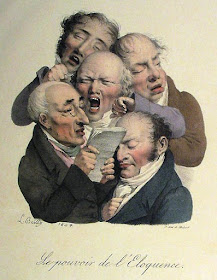 |
| Boilly (1761-1845), Les Grimaces, 3, lithographie, 1824 |
Grimacer est un art. Disparate, feinte ou spontanée, fine ou grossière, acrimonieuse ou affable, la grimace subjugue de sa présence expressive toutes les époques et captive toutes les disciplines artistiques. Couchée sur papier, colorée de pigment, taillée dans le marbre, sculptée dans l’albâtre ou encore fixée sur cliché, elle est envisagée dans tous ses états. Elle peut questionner les rapports entre le moral et le physique, là où les « visages insolents, excessifs ou hors de contrôle son aperçues comme une offense à l’encontre des règles de la beauté idéale » (Martial Guédron, L’art de la grimace, Paris : Hazan, 2011).
Spontanée, la grimace fut aussi perçue comme expression des caractères et des passions, comme l’indice d’une nature humaine à l’image d’un langage « primitif » prompt à trahir une animalité. Simulée ou envisagée du point de vue de l’artiste, de Jean-Jacques Lequeu aux productions photographiques contemporaines en passant par Franz Xavier Messerschmidt, elle rompt avec les canons fixant les représentations du corps. Aussi les caricaturistes de presse en feront- ils un vaste champ d’exploration. Travaillée enfin, la grimace put être perçue comme apparentée à l’hypocrisie sinon à la conspiration (Véronique Fau-Vincenti, « Caricatures », Le monde diplomatique, juillet 2011, p. 25).
 |
| Boilly, Une loge, un jour de spectacle gratuit, 1830. 32,5 x 41,7 cm. Musée Lambinet, Versailles |
 |
| Boilly, Les cinq sens, lithographie, 1823 |
EMPIRICISM. Roughly characterised, the backbone of empiricism is a simple claim: opinions are reasonable if, and only if, they are supported by evidence that is ultimately grounded in experience.
Experience, here, can mean everyday observation using one or more of the five senses, but it is also meant to include rigorous scientific experimentation. Respect for this principle is what supposedly sets the scientific age apart from the pre-scientific age. In that earlier age, unsupported speculation was purportedly rampant; since the scientific revolution, experience served to constrain such speculation.
Empiricists claimed that experience was the source of all genuine knowledge; claims that didn‘t ultimately spring from the senses were to be dismissed as fanciful. Boilly's caricatured personification of the senses reveals how not everyone was so convinced of the effectiveness of scientific methods at yielding all the truth and only the truth.
Expressed more negatively, empiricists are claiming that we should refuse to accept as true anything that has not been observed to be true. By this criterion, many religious doctrines are no more than unsupported speculation. Empiricists often denounced them as such in the period under discussion.
Empiricism as expressed in the simplified statement above has some embarrassing consequences. Moral and mathematical platitudes (e.g. that torturing people for fun is morally objectionable, or that 55 plus 55 necessarily equals 110) do not seem to require observational support, yet few would be prepared to denounce these judgements as unreasonable. The evidence for these and other reasonable opinions must come from some other source than the senses (openlearn).
 |
| Boilly, Réunion de 35 têtes d'expression. Musée des Beaux-Arts, Tourcoing |
 |
| Boilly, Les Grimaces, 7 |
 |
| Boilly, Le pouvoir de l'Eloquence, 1824 |
 |
| Boilly, Ah! le chic-en-lit, lit, lit, lithographie, 1824 |
Commons | Marinni
Facial expression | Expression faciale | Expresión facial
Guillaume Duchenne de Boulogne | Images
Paper Mate | World Historical Comics
Ref. caricature, series of ridiculous facial expressions, types.